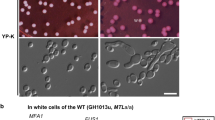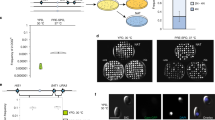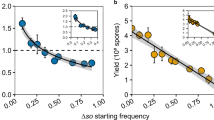Abstract
Candida albicans is the most common fungal pathogen in humans, causing both debilitating mucosal infections and potentially life-threatening systemic infections1,2. Until recently, C. albicans was thought to be strictly asexual, existing only as an obligate diploid. A cryptic mating cycle has since been uncovered in which diploid a and α cells undergo efficient cell and nuclear fusion, resulting in tetraploid a/α mating products3,4,5,6. Whereas mating between a and α cells has been established (heterothallism), we report here two pathways for same-sex mating (homothallism) in C. albicans. First, unisexual populations of a cells were found to undergo autocrine pheromone signalling and same-sex mating in the absence of the Bar1 protease. In both C. albicans and Saccharomyces cerevisiae, Bar1 is produced by a cells and inactivates mating pheromone α, typically secreted by α cells7,8,9,10. C. albicans Δbar1 a cells were shown to secrete both a and α mating pheromones; α-pheromone activated self-mating in these cells in a process dependent on Ste2, the receptor for α-pheromone. In addition, pheromone production by α cells was found to promote same-sex mating between wild-type a cells. These results establish that homothallic mating can occur in C. albicans, revealing the potential for genetic exchange even within unisexual populations of the organism. Furthermore, Bar1 protease has an unexpected but pivotal role in determining whether sexual reproduction can potentially be homothallic or is exclusively heterothallic. These findings also have implications for the mode of sexual reproduction in related species that propagate unisexually, and indicate a role for specialized sexual cycles in the survival and adaptation of pathogenic fungi.
This is a preview of subscription content, access via your institution
Access options
Subscribe to this journal
Receive 51 print issues and online access
$199.00 per year
only $3.90 per issue
Buy this article
- Purchase on Springer Link
- Instant access to full article PDF
Prices may be subject to local taxes which are calculated during checkout




Similar content being viewed by others
References
Samaranayake, L. P. et al. Fungal infections associated with HIV infection. Oral Dis. 8 (Suppl. 2). 151–160 (2002)
Wisplinghoff, H. et al. Nosocomial bloodstream infections in US hospitals: analysis of 24,179 cases from a prospective nationwide surveillance study. Clin. Infect. Dis. 39, 309–317 (2004)
Hull, C. M. & Johnson, A. D. Identification of a mating type-like locus in the asexual pathogenic yeast Candida albicans . Science 285, 1271–1275 (1999)
Hull, C. M., Raisner, R. M. & Johnson, A. D. Evidence for mating of the “asexual” yeast Candida albicans in a mammalian host. Science 289, 307–310 (2000)
Magee, B. B. & Magee, P. T. Induction of mating in Candida albicans by construction of MTL a and MTLα strains. Science 289, 310–313 (2000)
Miller, M. G. & Johnson, A. D. White-opaque switching in Candida albicans is controlled by mating-type locus homeodomain proteins and allows efficient mating. Cell 110, 293–302 (2002)
Hicks, J. B. & Herskowitz, I. Evidence for a new diffusible element of mating pheromones in yeast. Nature 260, 246–248 (1976)
MacKay, V. L. et al. The Saccharomyces cerevisiae BAR1 gene encodes an exported protein with homology to pepsin. Proc. Natl Acad. Sci. USA 85, 55–59 (1988)
Manney, T. R. Expression of the BAR1 gene in Saccharomyces cerevisiae: induction by the α mating pheromone of an activity associated with a secreted protein. J. Bacteriol. 155, 291–301 (1983)
Schaefer, D., Cote, P., Whiteway, M. & Bennett, R. J. Barrier activity in Candida albicans mediates pheromone degradation and promotes mating. Eukaryot. Cell 6, 907–918 (2007)
Bennett, R. J., Uhl, M. A., Miller, M. G. & Johnson, A. D. Identification and characterization of a Candida albicans mating pheromone. Mol. Cell. Biol. 23, 8189–8201 (2003)
Lockhart, S. R., Daniels, K. J., Zhao, R., Wessels, D. & Soll, D. R. Cell biology of mating in Candida albicans . Eukaryot. Cell 2, 49–61 (2003)
Panwar, S. L., Legrand, M., Dignard, D., Whiteway, M. & Magee, P. T. MFα1, the gene encoding the α mating pheromone of Candida albicans . Eukaryot. Cell 2, 1350–1360 (2003)
Jackson, C. L. & Hartwell, L. H. Courtship in Saccharomyces cerevisiae: an early cell-cell interaction during mating. Mol. Cell. Biol. 10, 2202–2213 (1990)
Segall, J. E. Polarization of yeast cells in spatial gradients of α mating factor. Proc. Natl Acad. Sci. USA 90, 8332–8336 (1993)
Hall, M. N. & Linder, P. The Early Days of Yeast Genetics (Cold Spring Harbor Laboratory Press, 1993)
Bennett, R. J. & Johnson, A. D. The role of nutrient regulation and the Gpa2 protein in the mating pheromone response of C. albicans . Mol. Microbiol. 62, 100–119 (2006)
Roberts, C. J. et al. Signaling and circuitry of multiple MAPK pathways revealed by a matrix of global gene expression profiles. Science 287, 873–880 (2000)
Odds, F. C. et al. Molecular phylogenetics of Candida albicans . Eukaryot. Cell 6, 1041–1052 (2007)
Butler, G. et al. Evolution of pathogenicity and sexual reproduction in eight Candida genomes. Nature 459, 657–662 (2009)
Bennett, R. J., Miller, M. G., Chua, P. R., Maxon, M. E. & Johnson, A. D. Nuclear fusion occurs during mating in Candida albicans and is dependent on the KAR3 gene. Mol. Microbiol. 55, 1046–1059 (2005)
Lin, X., Hull, C. M. & Heitman, J. Sexual reproduction between partners of the same mating type in Cryptococcus neoformans . Nature 434, 1017–1021 (2005)
Fraser, J. A. et al. Same-sex mating and the origin of the Vancouver Island Cryptococcus gattii outbreak. Nature 437, 1360–1364 (2005)
Lin, X. et al. Diploids in the Cryptococcus neoformans serotype A population homozygous for the α mating type originate via unisexual mating. PLoS Pathog. 5, e1000283 (2009)
Bui, T., Lin, X., Malik, R., Heitman, J. & Carter, D. Isolates of Cryptococcus neoformans from infected animals reveal genetic exchange in unisexual, α mating type populations. Eukaryot. Cell 7, 1771–1780 (2008)
Smulian, A. G., Sesterhenn, T., Tanaka, R. & Cushion, M. T. The ste3 pheromone receptor gene of Pneumocystis carinii is surrounded by a cluster of signal transduction genes. Genetics 157, 991–1002 (2001)
Noble, S. M. & Johnson, A. D. Strains and strategies for large-scale gene deletion studies of the diploid human fungal pathogen Candida albicans . Eukaryot. Cell 4, 298–309 (2005)
Reuß, O., Vik, A., Kolter, R. & Morschhauser, J. The SAT1 flipper, an optimized tool for gene disruption in Candida albicans . Gene 341, 119–127 (2004)
Guthrie, C. & Fink, G. R. Guide to Yeast Genetics and Molecular Biology (Academic Press, 1991)
Lockhart, S. R. et al. In Candida albicans, white-opaque switchers are homozygous for mating type. Genetics 162, 737–745 (2002)
Park, Y. N. & Morschhauser, J. Tetracycline-inducible gene expression and gene deletion in Candida albicans . Eukaryot. Cell 4, 1328–1342 (2005)
Alby, K. & Bennett, R. J. Stress-induced phenotypic switching in Candida albicans . Mol. Biol. Cell 20, 3178–3191 (2009)
Sherwood, R. K. & Bennett, R. J. Microtubule motor protein Kar3 is required for normal mitotic division and morphogenesis in Candida albicans . Eukaryot. Cell 7, 1460–1474 (2008)
Janbon, G., Sherman, F. & Rustchenko, E. Monosomy of a specific chromosome determines l-sorbose utilization: a novel regulatory mechanism in Candida albicans . Proc. Natl Acad. Sci. USA 95, 5150–5155 (1998)
Acknowledgements
The authors would like to thank D. MacCallum and the Aberdeen Fungal Group for strains, and J. Laney, T. Serio, R. Sherwood and M. Tessmer for discussions and critical reading of the manuscript. We also thank D. Koveal and S. Gilman for assistance during the preliminary stages of this work. R.J.B. holds an Investigator in the Pathogenesis of Infectious Disease Award from the Burroughs Wellcome Fund. K.A. was supported by a training grant for Graduate Assistance in Areas of National Need.
Author Contributions K.A. constructed mutant strains, analysed mating phenotypes, quantified mating frequencies and performed biofilm assays. D.S. constructed mutant strains, quantified mating frequencies and performed biofilm and halo assays. R.J.B. constructed mutant strains, quantified mating frequencies, performed adherence assays and analysed mating zygotes. K.A. and R.J.B. were involved in study design and writing of the manuscript.
Author information
Authors and Affiliations
Corresponding author
Supplementary information
Supplementary Information
This file contains Supplementary Notes, Supplementary Methods, Supplementary Figures 1-7 with Legends, Supplementary Tables 1-3 and Supplementary References. (PDF 5566 kb)
Rights and permissions
About this article
Cite this article
Alby, K., Schaefer, D. & Bennett, R. Homothallic and heterothallic mating in the opportunistic pathogen Candida albicans. Nature 460, 890–893 (2009). https://doi.org/10.1038/nature08252
Received:
Accepted:
Issue Date:
DOI: https://doi.org/10.1038/nature08252
This article is cited by
-
Structure and number of mating pheromone genes is closely linked to sexual reproductive strategy in Huntiella
BMC Genomics (2023)
-
Genetic Diversity of Human Fungal Pathogens
Current Clinical Microbiology Reports (2023)
-
Atmospheric humidity regulates same-sex mating in Candida albicans through the trehalose and osmotic signaling pathways
Science China Life Sciences (2023)
-
Hypha essential genes in Candida albicans pathogenesis of oral lichen planus: an in-vitro study
BMC Oral Health (2021)
-
Diverse transposable element landscapes in pathogenic and nonpathogenic yeast models: the value of a comparative perspective
Mobile DNA (2020)
Comments
By submitting a comment you agree to abide by our Terms and Community Guidelines. If you find something abusive or that does not comply with our terms or guidelines please flag it as inappropriate.



